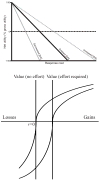Effort discounting in human nucleus accumbens
- PMID: 19246324
- PMCID: PMC2744387
- DOI: 10.3758/CABN.9.1.16
Effort discounting in human nucleus accumbens
Abstract
A great deal of behavioral and economic research suggests that the value attached to a reward stands in inverse relation to the amount of effort required to obtain it, a principle known as effort discounting. In the present article, we present the first direct evidence for a neural analogue of effort discounting. We used fMRI to measure neural responses to monetary rewards in the human nucleus accumbens (NAcc), a structure previously demonstrated to encode reference-dependent reward information. The magnitude of accumbens activation was found to vary with both reward outcome and the degree of mental effort demanded to obtain individual rewards. For a fixed level of reward, the NAcc was less strongly activated following a high-demand for effort than following a low demand. The magnitude of this effect was noted to correlate with preceding activation in the dorsal anterior cingulate cortex, a region that has been proposed to monitor information-processing demands and to mediate in the subjective experience of effort.
Figures



References
-
- Aguirre GK, Zarahn E, D’Esposito M. The variability of human BOLD hemodynamic responses. NeuroImage. 1998 in press. - PubMed
-
- Baxter MG, Murray AE. The amygdala and reward. Nature Reviews Neuroscience. 2002;3:563–573. - PubMed
-
- Botvinick M. Conflict monitoring and decision making: reconciling two perspectives on anterior cingulate function. Cognitive, Affective and Behavioral Neuroscience. 2007;7:356–366. - PubMed
-
- Botvinick M, Nystrom LE, Fissell K, Carter CS, Cohen JD. Conflict monitoring versus selection-for-action in anterior cingulate cortex. Nature. 1999;402(6758):179–181. - PubMed
-
- Botvinick MM, Braver TS, Barch DM, Carter CS, Cohen JD. Conflict monitoring and cognitive control. Psychological Review. 2001;108(3):624–652. - PubMed
Publication types
MeSH terms
Substances
Grants and funding
LinkOut - more resources
Full Text Sources
